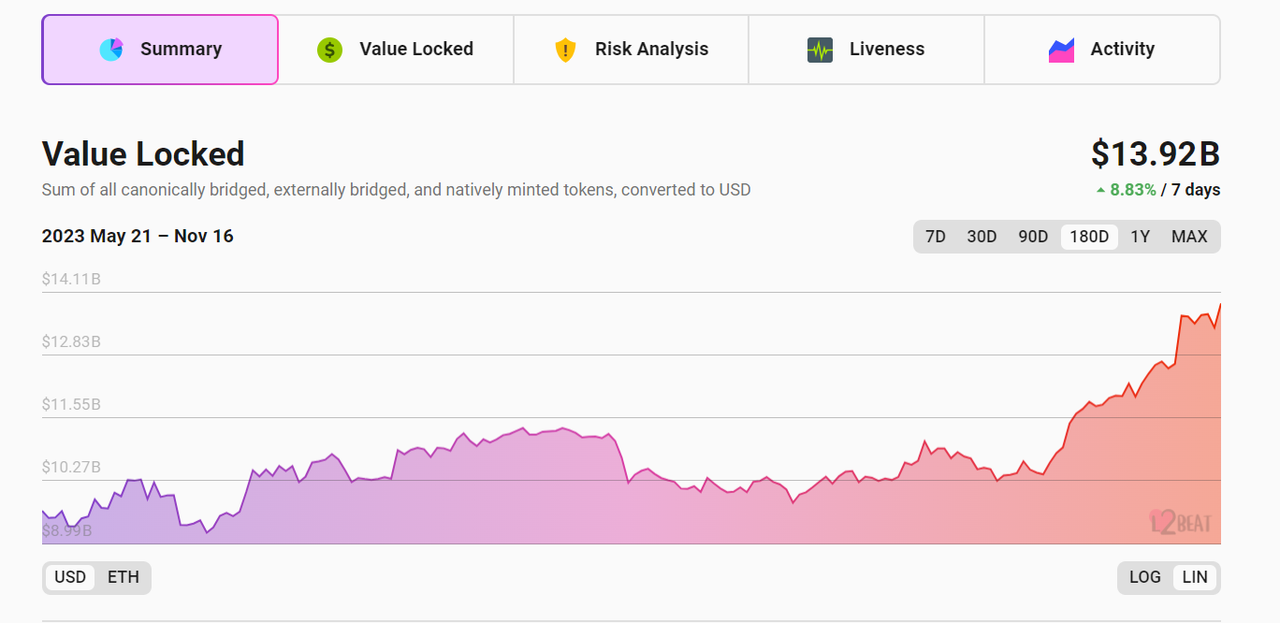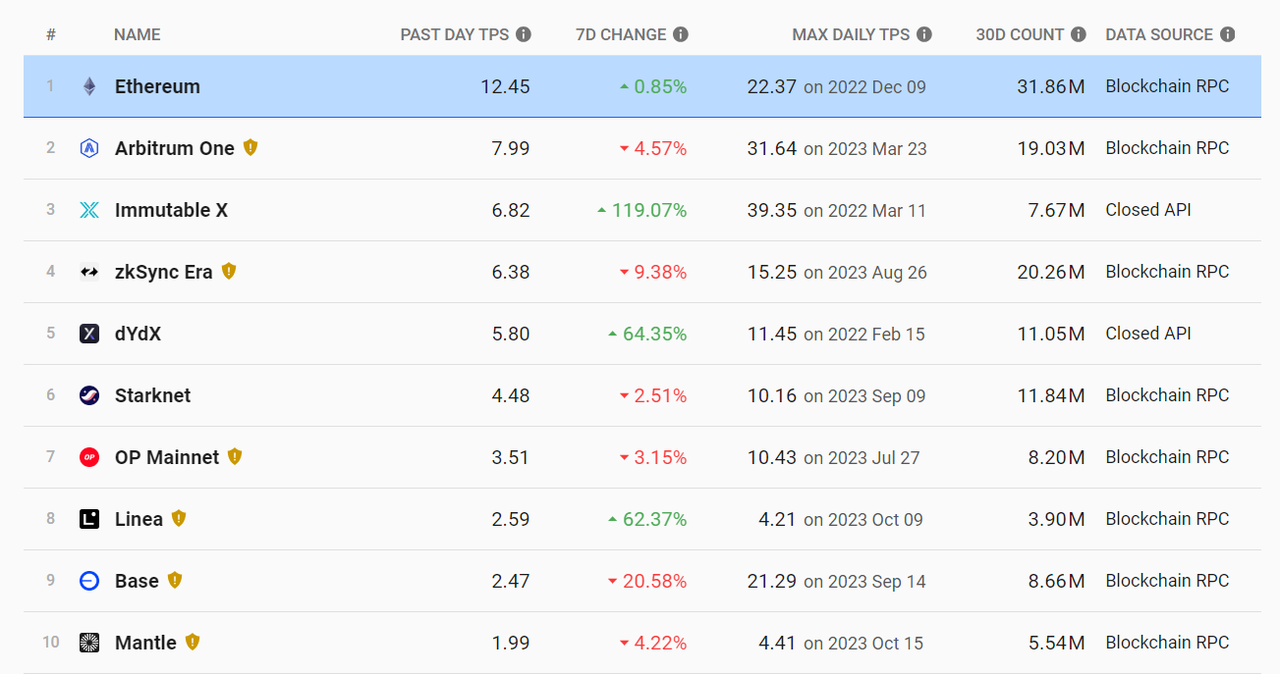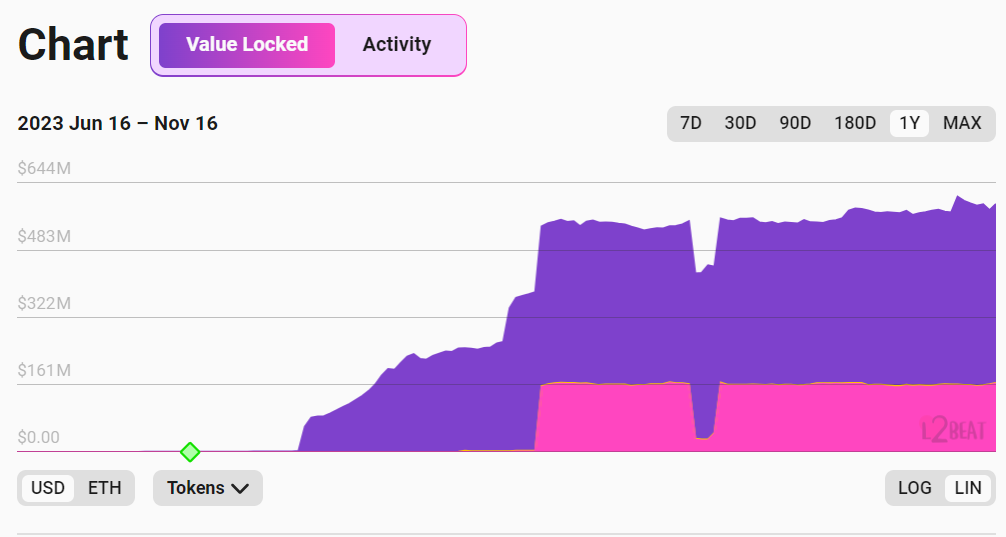In the exploration of a new chapter in blockchain technology, Layer 2 technology appears particularly important. It is a second-layer protocol built on top of the public blockchain (Layer 1), aiming to expand the transaction capacity and application scenarios of the blockchain. Currently, most Layer 2 solutions are built on the Ethereum network, which is particularly noteworthy.
The core of Layer 2 lies in building a second-layer protocol network outside the main chain, allowing the majority of transactions and tasks to be completed on Layer 2. Then, through various mechanisms, these results are periodically batched and submitted to Layer 1 for validation. The advantage of this approach is that it not only greatly improves the transaction speed of the blockchain, but also reduces transaction costs. More importantly, Layer 2 also inherits the advantages of public chains such as decentralization, security, and privacy protection.
According to L2beat's data, the total value locked (TVL) of Layer 2 has surpassed $13 billion, reaching $13.6 billion. This figure not only demonstrates the rapid development of Layer 2 technology, but also reflects the market's high recognition and trust in this emerging technology. With the continuous maturation and application of Layer 2 technology, we can anticipate that it will play an increasingly important role in the blockchain field.
 Trend chart of Layer2 project TVL in the past six months
Trend chart of Layer2 project TVL in the past six months
Next, we will delve into the world of Layer 2 and take a detailed inventory of several promising new projects. Through this analysis, we can not only better understand the potential of Layer 2 technology, but also gain insight into the trends in the future development of blockchain technology.
Why is Layer2 crucial? It can complement the multiple shortcomings of Layer1 and solidify the industry's technical foundation
In the journey of exploring blockchain technology, Layer 1 public chains, such as Ethereum, have laid the foundation for decentralization and resistance to censorship. However, their limitations in transaction speed and cost have become a significant bottleneck. Especially during the rapid development of DeFi, GameFi, and NFT in the bull market, network congestion and high gas fees have become major obstacles for users.
The allure of blockchain lies in providing a more economical and faster way of transacting. However, when transaction costs soar to hundreds of dollars, the advantages of blockchain over traditional payment methods such as Visa or PayPal are greatly diminished. Users who originally hoped to avoid high fees through blockchain transactions are now faced with even more expensive blockchain transaction costs, making it difficult for blockchain to attract a wider Web2 user base.
In this context, the importance of Layer 2 technology becomes increasingly prominent. Layer 2 effectively improves transaction processing speed and reduces gas fees by adding a new technical architecture on top of Layer 1. This innovation not only solves the scalability issues of Layer 1, but also allows ordinary users to easily access dApps and DeFi services, experiencing truly fast and economical blockchain transactions.
The advantages that Layer 2 brings to public chain networks include:
Enhanced transaction processing capacity: Since the transaction speed of Layer 1 is limited by block generation time, it is difficult to meet the needs of large-scale commercial applications. Layer 2 achieves efficient transaction processing by increasing transactions per second (TPS).
Reduced usage costs: Layer 2 operations can significantly reduce the high gas fees of Layer 1, making blockchain applications more feasible for a wider user base.
Expanded application scope: Layer 2 introduces more innovative features, such as enhanced privacy protection and cross-chain interaction, further broadening the application scenarios of blockchain.
Optimized user experience: Transaction processing in Layer 2 is more akin to the experience of traditional Web2 applications, making it easy for non-technical users to get started.
Enhanced security of Layer 1: By transferring a large number of transaction processing to Layer 2, the pressure on Layer 1 can be effectively reduced, thereby improving the overall system's security.
In summary, Layer 2 is not only a key to the advancement of blockchain technology, but also an important driving force for its widespread application. With the continuous development and popularization of Layer 2 technology, we can expect blockchain technology to have a more profound impact on various industries in the future.
After understanding the importance of Layer 2, we will now turn our attention to some notable Layer 2 new projects, gaining in-depth understanding of how they utilize these advantages, as well as their specific applications and impact in the blockchain field.
A glance at the popular star projects in the Layer2 race in 2023: From Base to Polygon zkEVM
As Layer 2 technology continues to advance, 2023 has witnessed the rise of several notable projects. Base, zkSync, and Mantle have not only made significant technological breakthroughs, but also achieved significant market share growth.

Top ten Layer2 projects
Base, zkSync, and Mantle are the star projects of this year, occupying 11% of the market share of the top 10 L2 solutions in October. These three projects were all launched this year, in March and July, and quickly gained a foothold in the market.
Base: Coinbase's Layer 2 innovative public chain
Base, launched by Coinbase, is an Ethereum Layer 2 network based on Optimism OP Stack. It is known for its high-speed, secure, and low-cost transaction environment. Base leverages Coinbase's strong support and popular SocialFi applications like friend.tech, providing a new DeFi ecosystem for Ethereum developers and Coinbase's user base.

Data table of Base public chain
As of October 2023, Base's total value locked (TVL) reached $300 million, accounting for 7.2% of the market share of the top 10 Layer 2 solutions. Base's rapid rise is attributed to Coinbase's strong support and the popularity of applications such as friend.tech.
zkSync: A technical solution combining privacy and efficiency
zkSync, a zk-Rollup project developed by Matter Labs, focuses on providing efficient, low-cost, and confidential transaction solutions for Ethereum. Since its launch in March, zkSync Era has become the seventh largest Layer 2 solution in the market, with a TVL of $120 million in October, accounting for 2.8% of the market share. One reason for zkSync's popularity is its attraction to users seeking airdrop rewards, who bridge funds to the network in hopes of additional returns.
Mantle: A Layer 2 innovative network launched by BitDAO
Mantle Network, launched by the leading decentralized autonomous organization BitDAO, adopts Optimistic Rollups technology, providing a faster and more economical transaction experience than Ethereum. Mantle's TVL exceeded $48 million in October, with a market share of 1.1%. The merger of BitDAO and Mantle Network has brought significant financial support to Mantle, allowing it to gain a foothold in the cryptocurrency field.
Polygon zkEVM: A dual advantage of EVM and zkRollup
Polygon zkEVM is a zk-Rollup solution launched by Polygon, combining the advantages of EVM compatibility and zkRollup. As of November 11th, its total locked value reached $100 million, with a 7-day increase of 32.42%, ranking it 10th among Layer 2 solutions.
Gnosis: A permissionless decentralized exchange, a major holder of sDAI
The Gnosis protocol is a permissionless decentralized exchange that significantly improves liquidity through ring trading mechanisms. Gnosis' TVL reached $160.1 million in October, accounting for 3.7% of the market share, a 2.47-fold increase compared to the beginning of the year. This growth is attributed to Gnosis Chain's support for sDAI, a stablecoin under MakerDAO. Gnosis Chain, as a major holder of sDAI, is becoming a key player in the tokenization of assets.
These Layer 2 projects not only demonstrate technological innovation, but also open up new paths for the future development of blockchain technology. With the maturity and development of these projects, they are expected to play a greater role in promoting the popularization and application of blockchain technology.
The breakthroughs in Layer2's technological innovation are worth attention, and there may be even higher-quality projects entering this race in the future
As we have delved into the emerging stars in the Layer 2 field in 2023, a clear trend has emerged: Layer 2 technology is not only maturing, but also shaping the future of cryptocurrencies and blockchain technology. From the rapid growth of Base to the privacy protection of zkSync, and to the innovative applications of Mantle and Polygon zkEVM, these projects showcase the diversity and potential of Layer 2 technology.
These advancements are not only significant for technology enthusiasts and developers, but also provide more choices and better experiences for ordinary users. With the improvement of transaction speed and cost reduction, Layer 2 solutions are breaking the boundaries of traditional financial services, bringing more convenient and economical digital asset trading to the public.
Looking ahead, we can expect Layer 2 technology to continue driving innovation and popularization of blockchain. With more projects and applications emerging, Layer 2 will not only be a branch of technology, but a key force driving the development of the entire cryptocurrency field. In this new era of Layer 2, we will witness more innovation, broader application scenarios, and deeper impact.
免责声明:本文章仅代表作者个人观点,不代表本平台的立场和观点。本文章仅供信息分享,不构成对任何人的任何投资建议。用户与作者之间的任何争议,与本平台无关。如网页中刊载的文章或图片涉及侵权,请提供相关的权利证明和身份证明发送邮件到support@aicoin.com,本平台相关工作人员将会进行核查。




